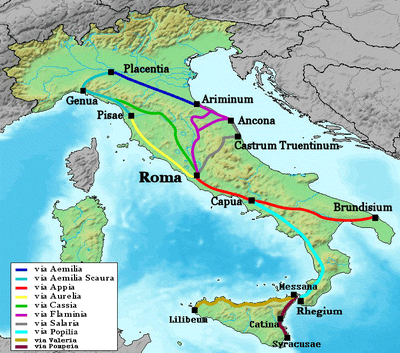Via Cassia

The Via Cassia was an important Roman road striking out of the Via Flaminia near the Milvian Bridge in the immediate vicinity of Rome and passing not far from Veii traversed Etruria.[1] The Via Cassia passed through Baccanae, Sutrium, Vulsinii, Clusium, Arretium, Florentia, Pistoria, and Luca, joining the Via Aurelia at Luna.[2]
Via Amerina
The Via Amerina was a road that broke off from the Via Cassia near Baccanae, and held north through Falerii, Tuder, and Perusia, rejoining the Via Cassia at Clusium. When the incursions of Faroald, the Lombard Duke of Spoleto, cut the Via Flaminia, the lifeline between Rome and Ravenna, the Via Amerina was improved and fortified at intervals, works that represented some of the last road-building carried out in Italy in Late Antiquity. As the new military and strategic route, the Via Amerina "became the communications core of Imperial Italy and the chief support to the claim that imperial Italy was still extant."[3]
Bridges
- For an overview of the location of Roman bridges, see List of Roman bridges.
There are the remains of several Roman bridges along the road, including the Ponte San Lorenzo and Ponte San Nicolao.
Sport
The road was used as part of the individual road race cycling route for the 1960 Summer Olympics in Rome.
See also
Notes
- ↑ Annapaola Mosca (2002). Via Cassia: un sistema stradale romano tra Roma e Firenze. Olschki.
- ↑ William Smith (1873). A Dictionary of Greek and Roman Geography. J. Murray. pp. 1297–.
- ↑ Jan T. Hallenbeck, "Pavia and Rome: The Lombard Monarchy and the Papacy in the Eighth Century" Transactions of the American Philosophical Society New Series 72.4 (1982 pp. 1-186) p 8.
External links
| Wikisource has the text of the 1911 Encyclopædia Britannica article Cassia, Via. |
- 1960 Summer Olympics official report. Volume 1. p. 84.
- 1960 Summer Olympics official report. Volume 2. Part 2. p. 319.
- LacusCurtius - "Viae" (Smith's Dictionary of Greek and Roman Antiquities 1875)
_pictogram.svg.png)